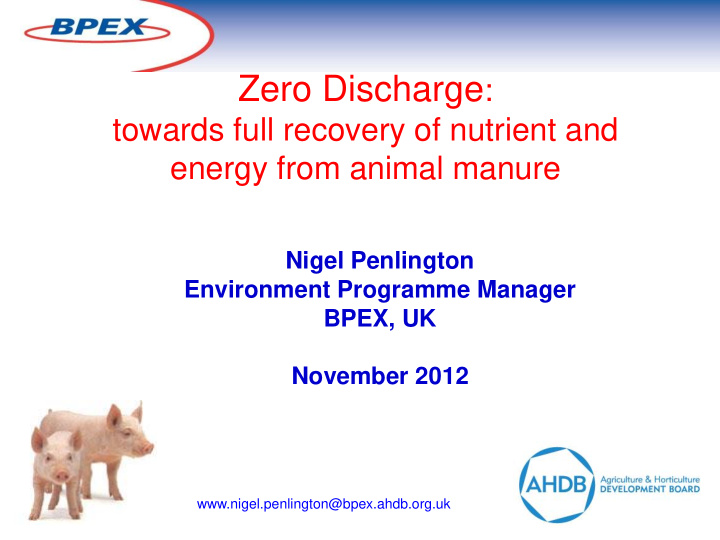



Zero Discharge : towards full recovery of nutrient and energy from animal manure Nigel Penlington Environment Programme Manager BPEX, UK November 2012 www.nigel.penlington@bpex.ahdb.org.uk
Zero discharge – Why? • Why – Finite resources vs. increased demand • Nitrogen, Phosphate, water, land, etc. – Energy hungry production systems – Environmental Protection – Sustainable food, products and service provision
Sustainability Meeting the needs of the present generation without compromising the ability of future generations to meet their needs.”
Limiting factors for global plant productivity Baldocchi et al. 2004 SCOPE 62
Water for life • Essential for plant growth and livestock • Changing patterns • Will dictate what can be grown and produced where
Protect the Natural Environment • Resources • Habitats • Eco systems • Getting the balance right
Zero discharge – How? • Consider the full system – integrated approach. • Don’t push losses along the line • End to Start or Start to End? – The product, i.e. the reason – Consequences of actions e.g. nutritional strategy • Applied to; – Existing systems – New systems • Windfall Opportunities – Counteract inevitable losses
Integrated Systems
Feed, Housing, Manures >£ >£ <CH 4 <NH 3 HEAT <N 2 O Inputs Kg £ Sun <P <NO 3 Water
Integrated Systems to minimise losses • Location • Animal Health • Feed inputs • Housing • Manure storage • Manure processing • Manure utilisation • Product utilisation
Minimising losses - Location • Marketable yield • Recovery – Heat – Water – Manures – Generated energy
Minimising Losses – animal health • Growth rate • Resource use • Product quality & rejections • Death = waste
Precision Feeding & Real Time Monitoring
Growth Monitoring - pigs Silsoe Livestock Systems Ltd
Minimising losses - Housing • Low emission housing • Combine with low protein diets – Faeces/urine – Frequent manure removal • Slats/part solid • solid/solid with gutter • Scrape • Flush • Acidification – Manure cooling – Straw to absorb • Welfare – loose vs. restrained
Minimising losses – housing 2 • Ventilation rate • Air movement paths • Heat exchangers – 110kg pig = 150W • Exhaust air cleaning (ammonia & dust) • Opportunities to offset – Solar heat and power – Ground source heat – Water harvesting
BAT Part slated floor with manure cooling fins BREF. Figure 4.23: manure surface cooling fins. Wageningen
Heat Recovery in a Broiler House BREF Figure 4.3
Minimising losses – Manure Storage • Appropriate storage • Separation • Covering • Diffuse aeration/conditioning • Use of additives • Holding capacity matched to application timing
Minimise Losses – manure processing • Anaerobic digestion – Heat, power – Improved N availability, reduced seed and pathogen burdens • Ammonium extraction • Phosphate rebalancing and stripping • Heat from manure stores • Gasification
Minimising Losses – manure application • Analysis – Laboratory • Chemical • Near Infrared Spectrometry – On farm test kits • Planning as part of fertilisation regime – Professional advisers – Decision support tools (MANNER NPK) • Homogenous or fractions • Application techniques
Minimising losses – manure application • Application techniques – Timing – Uniformity – Low emissions – Low soil losses – Minimise crop damage/quality impacts
Crop nutrients
Recovering Livestock N • Treatment – Separate – De- nitrification – Recover • Transport
Phosphate Recovery
Anaerobic Digestion
Minimising losses – product utilisation • Extract full value – Meat cuts – Offals – Oils & fats – Hides, skins, feathers etc – Processed animal protein (PAP)
Pigmeat Trade Flows (incl. live), 2010 with trend to 2020 Flows in '000 t cwe 5-10 10-25 25-50 50-75 75-100 100-200 Red arrow: decrease forecast in n+10 Black arrow: no significant change > 200 Blue arrow: increase forecast in n+10
Successful sector Animal Welfare Customer Aspirations Meat Quality & Safety Return on Investment
Drivers to Change • Legislation? • Financial – Lean manufacturing – Process analysis – Adopting technology and improving skills – Returns to stimulate investment Those who rise to the challenge will not only survive but prosper
Thank You www.bpex.org.uk
Recommend
More recommend